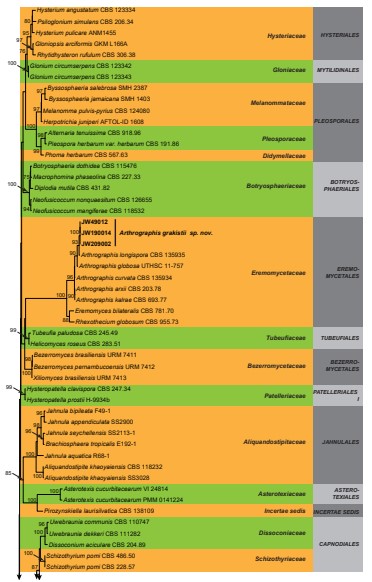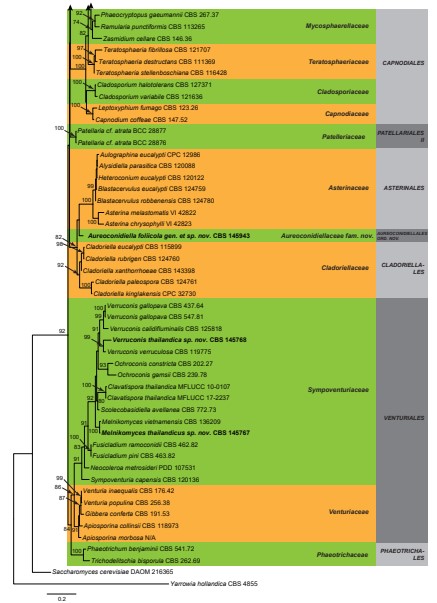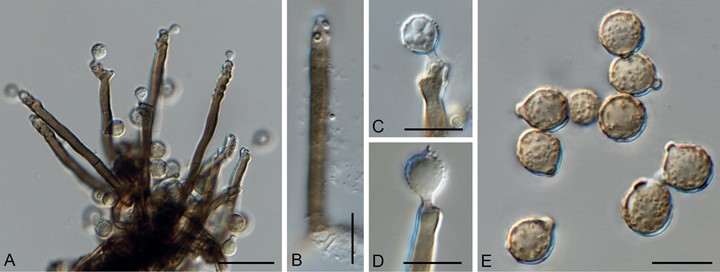Aureoconidiella foliicola Hern.-Restr. & Crous, sp. nov.
MycoBank number: MB 833916; Index Fungorum number: IF 833916; Facesoffungi number: FoF 10817; Fig. 4.
Etymology: The epithet “foliicola” refers to its habitat on a dead leaf.
Mycelium consisting of septate, smooth, brown, 1–2.5 µm wide hyphae. Conidiophores macronematous, simple, septate, brown, 40–85 × 3–5.5 µm. Conidiogenous cells integrated, terminal, polyblastic, with thickened scars, brown to pale brown, 25–53 × 3–4.5 µm. Conidia globose to subglobose with apiculate base, initially subhyaline, golden brown at maturity, verrucose, 5–8 µm diam, base 1–2 µm wide.
Culture characteristics: On MEA and OA surface cottony aerial mycelium Fawn, sepia to dark brick close to the agar, margin effuse, entire; reverse sepia to black.
Typus: South Africa, KwaZulu-Natal, Richards Bay, on living leaves of Syzygium cordatum (Myrtaceae), Jun. 2016, M.J. Wingfield (holotype CBS H-24099, culture ex-type CPC 36154 = CBS 145943).
Notes: This new lineage is introduced to accommodate a fungus characterised by unbranched conidiophores, cicatrised and sympodial conidiogenous cells with thickened scars, producing sub-globose, verruculose, and golden brown conidia. Other related lineages are those accommodating Asterinales and Cladoriellales (Fig. 1). However, they differ from those in the Aureoconidiellales based on the morphology of the asexual morphs. The Asterinales is mainly characterised by taxa that are coelomycetes with pycnothyrial conidiomata (Guatimosim et al. 2015, Jaklitsch et al. 2016). The Cladoriellales is a monotypic order related to cladosporium-like hyphomycetous fungi with conidia frequently remaining attached in long acropetal chains (Crous et al. 2006c, 2017).
Authors: M. Hernández-Restrepo, P.W. Crous and M.J. Wingfield

Fig. 1. Maximum composite likelihood tree obtained from the RAxML analysis of the LSU sequence alignment of selected Dothideomycetes. Bootstrap support values above 70 % are shown at the nodes. Families and orders are indicated with coloured blocks to the right of the tree. Taxonomic novelties described in this study are indicated in boldface. The tree was rooted to Yarrowia hollandica (CBS 4855).

Fig. 1. (Continued)

Fig. 4. Aureoconidiella foliicola gen. et sp. nov. (CBS 145943). A. Conidiophores and conidia. B. Conidiophore with conidiogenous cell. C, D. Conidiogenous cells giving rise to conidia. E. Conidia. Scale bars: A = 20 μm, all others = 10 μm.
